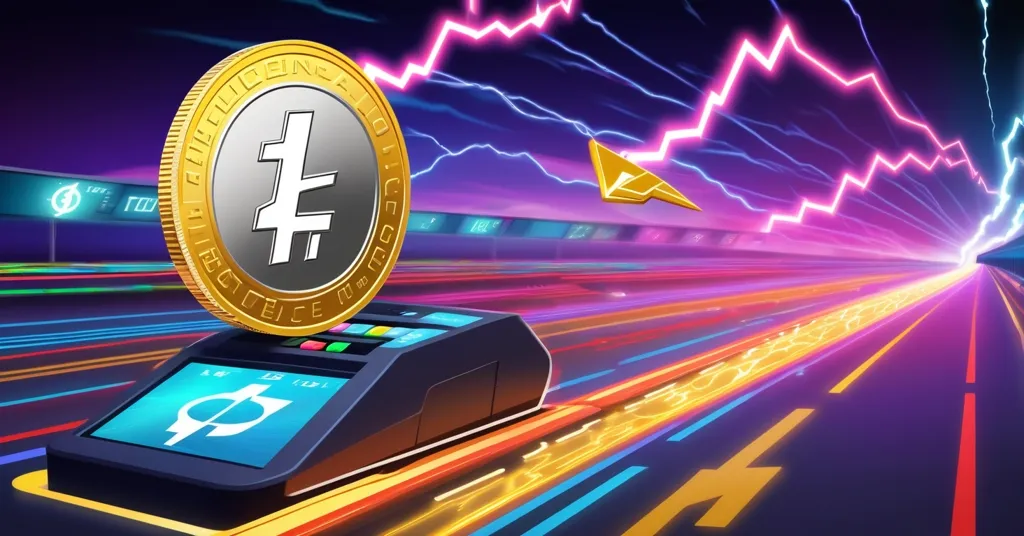Litecoin Claims #2 in Crypto Payments: CoinGate Data Shows Speed and Cost Edge

Litecoin Surges to #2 in Crypto Payments: CoinGate Data Reveals Why
Litecoin (LTC) has just shot up to the second spot in cryptocurrency payments, per the latest figures from CoinGate, a Lithuanian payment processor. In a space where Bitcoin reigns supreme, this scrappy altcoin is flexing its muscle with speed and affordability, overtaking stablecoins and other contenders in a surprising shake-up of user preferences. Let’s unpack what’s driving this surge and whether it’s a flash in the pan or a sign of lasting change.
- Litecoin’s Rise: LTC captures 14.5% of payment share in July, jumping ahead of USDC (14%) and USDT (12.2%).
- Bitcoin’s Grip: BTC holds firm at 22.9%, still the top dog for transactions on CoinGate.
- Merchant Shift: 40.9% of merchants settled in crypto in H1 2025, up from 27% in 2024, though stablecoins dominate payouts.
Litecoin’s Payment Power: Speed and Cost Win Out
CoinGate’s July data offers a hard look at how crypto users are voting with their wallets. Bitcoin, no shock here, leads the pack with a 22.9% share of transactions. It’s the digital gold standard—trusted as a store of value, widely accepted, and the default for many. But Litecoin’s climb to second place with a 14.5% share—up from 13.6% in the first half of 2025—has heads turning. For perspective, LTC ranks a measly 19th by market cap, yet it’s outpacing big names like USDC (14%), USDT (12.2%), and Tron (12.9%) in actual payments. What’s the secret sauce? It boils down to efficiency. Litecoin, often called “digital silver” to Bitcoin’s “digital gold,” was built for quick, cheap transactions. We’re talking block confirmation times of 2.5 minutes—how long it takes for a transaction to be verified on the blockchain, a shared digital ledger—versus Bitcoin’s lethargic 10 minutes. Fees? Often under a penny for LTC, while BTC can hit $5 or more when the network’s clogged. For anyone buying a coffee or tipping online, that’s a no-brainer.
Peering into the rest of July’s rankings, stablecoins like USDC and USDT hang tough, favored by users dodging crypto’s wild price swings with their peg to fiat like the US dollar. Tron, at 12.9%, keeps a foothold too, likely thanks to dirt-cheap transfers in certain decentralized finance (DeFi) circles. Rewind to H1 2025 data, though, and the picture shifts: Bitcoin sat at 23.3%, Tron surprisingly led altcoins at 21.6%, Litecoin was at 13.6%, and Ethereum clocked 13.5%. Ethereum’s fade in the latest stats might tie to its infamous gas fees—costs for network usage that spike with demand—making users balk at paying $20 just to send $10. Litecoin, meanwhile, is staking a claim as the go-to for practical payments: less fanfare, more function. For more on this trend, check out the latest CoinGate report on payment trends.
Merchants Hesitate: Volatility Keeps Litecoin at Arm’s Length
Switching gears to merchants, CoinGate’s numbers tell a different tale. There’s a clear spike in trust for digital assets—40.9% of merchants opted for crypto settlements in H1 2025, up from a cautious 27% in 2024. That’s a loud signal businesses are warming to crypto as real money, not just speculative fluff. But here’s the rub: when it’s time for payouts, Litecoin’s nowhere on their radar. USDC takes the crown, with Bitcoin trailing behind, as merchants crave stability. Stablecoins, tied to fiat values, shield them from crypto’s stomach-churning ups and downs—think LTC jumping 9% to $119 (or $122 by some trackers) in just 24 hours. That volatility, while exciting for traders, is a nightmare for anyone balancing a ledger. It’s a harsh reality check: user love for Litecoin’s payment perks doesn’t equate to business confidence. Could hybrid systems—converting LTC to stablecoins instantly at checkout—bridge this gap? Maybe, but for now, merchants are playing it safe, and it’s a hurdle LTC must clear to cement its role. Some community discussions highlight merchant preferences for stablecoins over LTC.
Price Surge: Utility or Just Hype?
Speaking of that 9% price leap to $119–$122, Litecoin’s market action is grabbing attention beyond payments. Is this tied to its CoinGate surge, or is it another crypto hype wave? Some market watchers point to resistance levels around $121–$122, warning the rally might fizzle back to $115 if buying momentum stalls. They note the price looks overextended, hinting at a short-term correction before any shot at $130. Let’s cut the BS—we’re not here to peddle moonshot fantasies or fake trade calls. The real question is whether this bump reflects genuine belief in Litecoin’s payment utility or just speculative noise. Crypto’s littered with pump-and-dump corpses, and while LTC’s transaction stats scream legitimacy, price spikes often lure in gamblers over adopters. It’s a tension worth chewing on, especially as Bitcoin’s own price swings rarely dent its credibility as digital money’s bedrock. For deeper insights, see this analysis of Litecoin’s recent price surge.
Privacy Edge: MimbleWimble and Litecoin’s Hidden Strength
Digging beneath speed and cost, Litecoin packs another punch with its MimbleWimble Extension Blocks (MWEB) protocol, rolled out for opt-in privacy. Unlike many privacy coins needing separate tokens or clunky setups, MWEB lets users hide transaction details natively while keeping the blockchain auditable if needed. For the uninitiated, this means you can send LTC discreetly—say, for a private tip or purchase—without waving a red flag to regulators, unlike fully anonymous coins like Monero that often draw heat. Does this drive CoinGate’s payment numbers? Hard to say without direct data, but for users or even merchants valuing discretion alongside transparency, it’s a slick feature. Still, privacy tech walks a tightrope—too much secrecy, and governments might crack down harder. It’s a niche perk, but one that could quietly fuel LTC’s appeal if marketed right. Curious about LTC’s background? Learn more from its detailed overview on Wikipedia.
The Bigger Picture: Crypto Payments on the Rise
Zooming out, Litecoin’s climb on CoinGate mirrors a broader push for crypto in real-world payments. Global adoption in e-commerce and remittances is ticking up—think platforms like BitPay or Flexa processing millions in transactions yearly—as users and businesses seek alternatives to slow, costly bank transfers. Litecoin’s edge in speed and fees positions it well here, especially against Bitcoin’s heftier costs or Ethereum’s unpredictable charges. But it’s not alone—other low-cost chains like Solana or Polygon are vying for the same turf with sub-second confirmations and near-zero fees. Is LTC’s surge a unique win, or just a beneficiary of Bitcoin’s fee spikes pushing users to cheaper options temporarily? That’s the devil’s advocate take, and it’s not far-fetched given crypto’s fickle trends. For a comparison, check out this breakdown of Litecoin versus Bitcoin on transaction speed and fees.
Looking Ahead: ETFs and Regulatory Minefields
Peering into Litecoin’s future, there’s buzz around institutional moves. Applications for Litecoin-linked spot ETFs—exchange-traded funds that let traditional investors buy into LTC without holding it—by firms like Grayscale, CoinShares, and Canary Capital hint at mainstream potential. If greenlit, these could flood LTC with big money, maybe taming its wild price swings and boosting visibility. But let’s not kid ourselves—regulatory approval is a gauntlet. Bitcoin and Ethereum ETFs barely squeaked through after years of rejections, and altcoins face steeper odds. Even if approved, ETFs won’t magically fix volatility or merchant hesitance. Plus, as crypto payments grow, so does the shadow of regulation. Look at past crackdowns—India and China have throttled payment-focused cryptos before—and it’s easy to see governments clamping down on anything threatening centralized control. This is why decentralization remains our north star: systems like LTC challenge the old financial guard, prioritizing user freedom over bureaucratic chokeholds. Community chatter on Litecoin’s payment surge also reflects this sentiment.
Historical Grit: Litecoin’s Underdog Journey
A quick rewind to Litecoin’s roots adds context. Born in 2011 from Charlie Lee’s vision, LTC was crafted as Bitcoin’s lighter, faster cousin, tailored for everyday use over speculative hoarding. It’s had moments of payment relevance before, often peaking when BTC fees soared, though never quite shedding its “also-ran” label. Now, with CoinGate’s data, it’s clawing back relevance—not through hype, but hard utility. Yet, Bitcoin maximalists might scoff: BTC’s the fortress of freedom, the unassailable standard of decentralized money. Fair enough, but Litecoin’s playing the nimble scout, slipping through the cracks of daily finance where Bitcoin’s bulk can’t fit. In a world craving disruption, isn’t there space for both? If you’re wondering why Litecoin stands out for payments, there’s plenty of discussion out there.
Key Takeaways and Questions on Litecoin’s Payment Surge
- Why is Litecoin outpacing others in crypto payments?
Its 2.5-minute block times and fees under $0.001 make Litecoin transaction speed and low-cost crypto payments unbeatable for everyday use, unlike Bitcoin’s pricier, slower setup. - How does Bitcoin stack up in this payment race?
Bitcoin holds a dominant 22.9% share on CoinGate, remaining the trusted default for many despite higher fees and longer 10-minute confirmations. - Why do merchants skip Litecoin for payouts?
Volatility is the likely culprit, driving merchants to stablecoins like USDC for price stability pegged to fiat, avoiding LTC’s unpredictable swings. - Is Litecoin’s 9% price jump to $119–$122 sustainable?
Market signals suggest a possible pullback to $115 due to overextended buying, hinting the surge might reflect short-term hype over lasting payment-driven demand. - What could boost Litecoin’s adoption down the line?
Features like MWEB for privacy, potential spot ETF approvals, and growing crypto payment trends could elevate LTC, though regulatory risks and competition from chains like Solana loom large.
So, where does Litecoin stand in this messy, thrilling crypto saga? Its leap to second place on CoinGate screams utility—proving that solving real problems like fast, cheap payments can outshine market cap swagger. Yet, it’s no fairy tale. Merchant wariness, price rollercoasters, and the ever-looming regulatory hammer remind us crypto’s road to revolution is paved with potholes. Bitcoin’s throne as the ultimate decentralized titan isn’t budging, but Litecoin’s carving a gritty niche, showing silver can gleam just as fierce as gold. If it keeps flexing these payment chops, could even the staunchest Bitcoin maximalists start rethinking what “digital money” means in a truly free financial future? That’s the kind of question that keeps this space electric. For further verification of these stats, take a look at the detailed analysis of Litecoin’s July surge.



